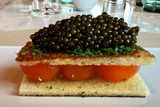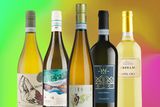Paolo Tullio: Tantalising tapas in Zaragoza
Zaragoza: 18-19 South William Street, Dublin 2. Tel: (01) 679 4020
Zaragoza restaurant
Five or six years ago, practically every new eaterie that opened served tapas. Tapas were everywhere, from Dublin city centre to small provincial towns. There was a moment during those years when I thought that soon, if the trend continued, tapas would be the only option for a diner, but over the past few years, the tapas craze seems to have abated a bit.
What seems to have happened is that a proper tapa, just a small plate of something tasty, left the average diner feeling unfulfilled. Thankfully, the Spanish have an answer to that, and they're called raciones. These are just like the tapas, but they're bigger. Two raciones would be enough to fill you, whereas you might need four or five tapas.
Anyway, there's a new tapas emporium in South William Street called Zaragoza. Inside, it's very new and shiny, and clearly a lot of money has been spent on the décor. It's on several levels, so you don't feel that you're in a barn, as each area fills up separately. I was there to meet Gerard Carthy of TasteofIreland.com and we booked early - for half past five. Even that early there were people dining, and by 6.30pm the place was very busy.
The menu is a combination of tapas, pinchos and raciones, so you can satisfy your hunger to perfection. It's divided into sections - pinchos, fish tapas, cold platters, meat tapas, vegetarian tapas and desserts. As ever, we got carried away and ordered far more food than we could eat, going for the chicken croquetas, the seared tuna, stuffed mini peppers, fried scallops, meatballs, fried chorizo and, lastly, patatas bravas. The scallops and the tuna steak were €12.90, all the others were €8.90.
Although neither Gerard nor I were drinking, I gave a few moments to the wine list. There are good things about it, for example all wines are available by the glass, the 500ml carafe, and by the bottle. But there are bad things about it too, namely only two wines priced at under €30. This is increasingly becoming a problem on wine lists, because with owners trying to make a three-times mark-up, and governments upping their share as well, it's becoming really hard to find a wine for around a fiver that can be sold for thirty quid on a list.
The tapas started to come to our table a few at a time, starting with the chicken croquetas, the tuna steak and the patatas bravas. Croquetas are probably my favourite tapa, either ham or chicken, and they're based on a thick béchamel, which is then flavoured, crumbed and fried. There were quite a lot of chicken croquetas on the plate, and I happily launched into them. Meanwhile, Gerard was discovering that the best way to eat tuna - assuming it's a fresh piece - is raw. Seared is good too, as only the outside of the steak gets ruined.
I've said it before, the Japanese are right, tuna is at its best uncooked. Cooking changes the texture hugely, and in my opinion for the worse, giving the cooked fish a dry, hard finish, whereas raw it has the texture of a luscious smoked salmon. The patatas bravas looked good, as they were served with the salsa on the side in a little jug. The little cubes of potato had been perfectly cooked, crunchy on the outside and soft and fluffy in the middle. I liked the spiciness of the salsa too, so I was happy to pour some on to the potato cubelets. Keeping the salsa and the cubelets apart makes sure that the patatas don't have a soggy bottom.
Next to come to the table were the stuffed peppers, the scallops, the meatballs and the fried chorizo. We'll take them one at a time. The small red stuffed peppers made a dull dish, I thought, but the meatballs were very well done, having exactly the right consistency. By that I mean when you cut into them, they didn't disintegrate, but held their form. They were also very well flavoured, with enough pimiento to give them that distinctively Spanish flavour.
The scallops were placed in front of me, so I decided they were mine and I'd eat them. They really were delicious. You'd think that frying fatty chorizo in olive oil would make the dish far too oily, but it's one of those counter intuitive things, in fact what happens is that as the slices of chorizo fry, the fat renders and adds itself to the oil. So unless you actually spoon the oil and fat out of the bowl, you'll just get the meat and none of the fat.
Sensible people would have stopped right here, after these last dishes. But we weren't being sensible. Instead we ordered a dessert to share, a crema Catalana, a dish that's almost indistinguishable from crème brûlée. It was a good example of the genre and very soon it too was gone.
We wound up our meal with an Americano for Gerard and an espresso for me, which brought the bill to €74.70. To sum up, this had been good, but not exceptional food, very good service in a pleasingly decorated room. You can get more authentic tapas, closer to the Spanish original, but this offering is well designed to appeal to the Irish palate.
On a budget
There's an early bird tapas platter from 3.30pm to 6.30pm, Monday to Sunday. You get six tapas, plus a bottle of water, for just €17.
On a blowout
The most expensive dish is the platter of Iberico ham with quince and crispy bread at €17.50. Otherwise there are four fish tapas priced at €12.90.
Food: 7/10
Ambience: 8/10
Value for money: 8/10
Overall: 23/30
Whispers from the gastronomicon
Those of us who enjoy the freedom of buying raw milk can relax a little. The current status is that raw milk remains legal under the EU Hygiene directive of 2006 in the absence of any specific Irish regulations.
Recent statements from the Government indicate that they are working on regulations and do now not intend to ban the sale of raw liquid milk. This is a crucial time though, as the food and farming communities need to be involved in these regulations to ensure that they are workable, fair, safe and, most of all, risk appropriate.
Both the Campaign for Raw Milk Ireland and Slow Food Ireland have written to the Ministers for Health and Agriculture requesting further information and that stakeholders be allowed to participate.
We need to encourage everyone to write to their local TDs and to the Minister to ensure that we get a chance to participate in the process of regulations. There is a simple draft letter and instructions including details of all TDs available on the website below: rawmilkireland.com
Email: paolo@foodandwine.net
Join the Irish Independent WhatsApp channel
Stay up to date with all the latest news














